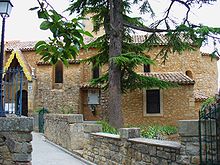Rennes-le-Château
| Rennes-le-Château | ||
|---|---|---|

|
|
|
| region | Occitania | |
| Department | Aude | |
| Arrondissement | Limoux | |
| Canton | La Haute-Vallée de l'Aude | |
| Community association | Limouxin | |
| Coordinates | 42 ° 56 ' N , 2 ° 16' E | |
| height | 272-568 m | |
| surface | 14.68 km 2 | |
| Residents | 80 (January 1, 2017) | |
| Population density | 5 inhabitants / km 2 | |
| Post Code | 11190 | |
| INSEE code | 11309 | |
| Website | www.rennes-le-chateau.fr | |
Rennes-le-Château ( Rènnas del Castèl in Occitan ) is a medieval village with 80 inhabitants (as of January 1, 2017) in southern France , 481 m above sea level, in the Aude department in the Occitania region , about 40 kilometers south of Carcassonne and about twelve kilometers from the Pic de Bugarach .
Population development
| year | 1962 | 1968 | 1975 | 1982 | 1990 | 1999 | 2006 | 2016 |
| Residents | 101 | 90 | 80 | 63 | 88 | 111 | 90 | 77 |
| Sources: Cassini and INSEE | ||||||||
Village
In addition to the Château d'Hautpoul, which is not open to the public, there is the village church of Sainte Marie-Madeleine , inaugurated in 1059 and essentially Romanesque , which was renovated and popularly redesigned from 1891 by Bérenger Saunière , the pastor of the village at the time. It was only through modern myth that it became widely known. A restaurant and a bookstore are frequented by tourists, as is the Abbé library tower, the Tour Magdala , located on a hill . A few meters next door, Saunière built his house, the Villa Béthania , which is separated from the tower by a large garden.
Modern legend formation
The restaurant owner Noel Corbu acquired the Villa Bethania des Abbé in 1946 and opened a restaurant there in 1950. He claimed of the Abbé that he had found the Holy Grail in the village around 1900 together with the treasures of the Templars ( Templar treasure ), Cathars or even Goths and had become immeasurably rich. During the renovation of the altar, Saunière found an old parchment apparently hidden there with a strange Christian message. Pierre Plantard took the rumors into his mythology about the Prieuré de Sion and thus spread them.
The place first gained general fame through the bestseller The Holy Grail and its Heirs , in which the British authors Michael Baigent , Henry Lincoln and Richard Leigh processed the legend of Rennes-le-Château. In 1988 Umberto Eco used elements from it for his novel The Foucault Pendulum . The computer adventure Gabriel Knight 3 - Blood of the Saints, Blood of the Damned by Jane Jensen , published in 1999 and set in Rennes-le-Château and its surroundings, is based on this theme.
Dan Brown picked up on the legend of the Prieuré de Sion for his 2003 bestseller, The Da Vinci Code , which made the topic even more popular. Also in 2003, the novel The Heiress of the Grail by Helene Luise Köppel , set in Rennes-le-Château, was published in German-speaking countries . Also in the 2006 novel The Gospel of Magdalena by Kathleen McGowan , the 2007 novel Calix by DL Wilson and in the 2008 novel The Eighth Map by the author Kate Mosse , the location becomes the central point of the plot.
Due to the speculation about Saunière, the village has been experiencing a tourism boom for many years, the by-product of which are numerous amateur excavations by treasure hunters.
literature
- Jean-Luc Robin: Rennes-le-Chateau. Mon village à l'heure du “Da Vinci”. Chroniques. Sud-Ouest, Bordeaux 2006, ISBN 2-87901-737-8 (French).
Documentation
- Secret acts of sacrilege. The Myth of Rennes le Chateau , TV documentary as part of the Terra X series , ZDF ( online )
- The Pastor and the Holy Grail , television documentary as part of the series Mythenjäger , ZDF ( online )
Web links
- www.rennes-le-chateau.fr , Official website of Rennes-le-Château (French, English, Spanish)
- www.octonovo.org , documentation of a resident of Rennes-le-Château (French)
Individual evidence
- ^ IGN map, sheet 2347, 1994.


